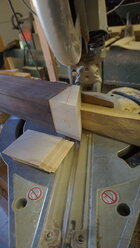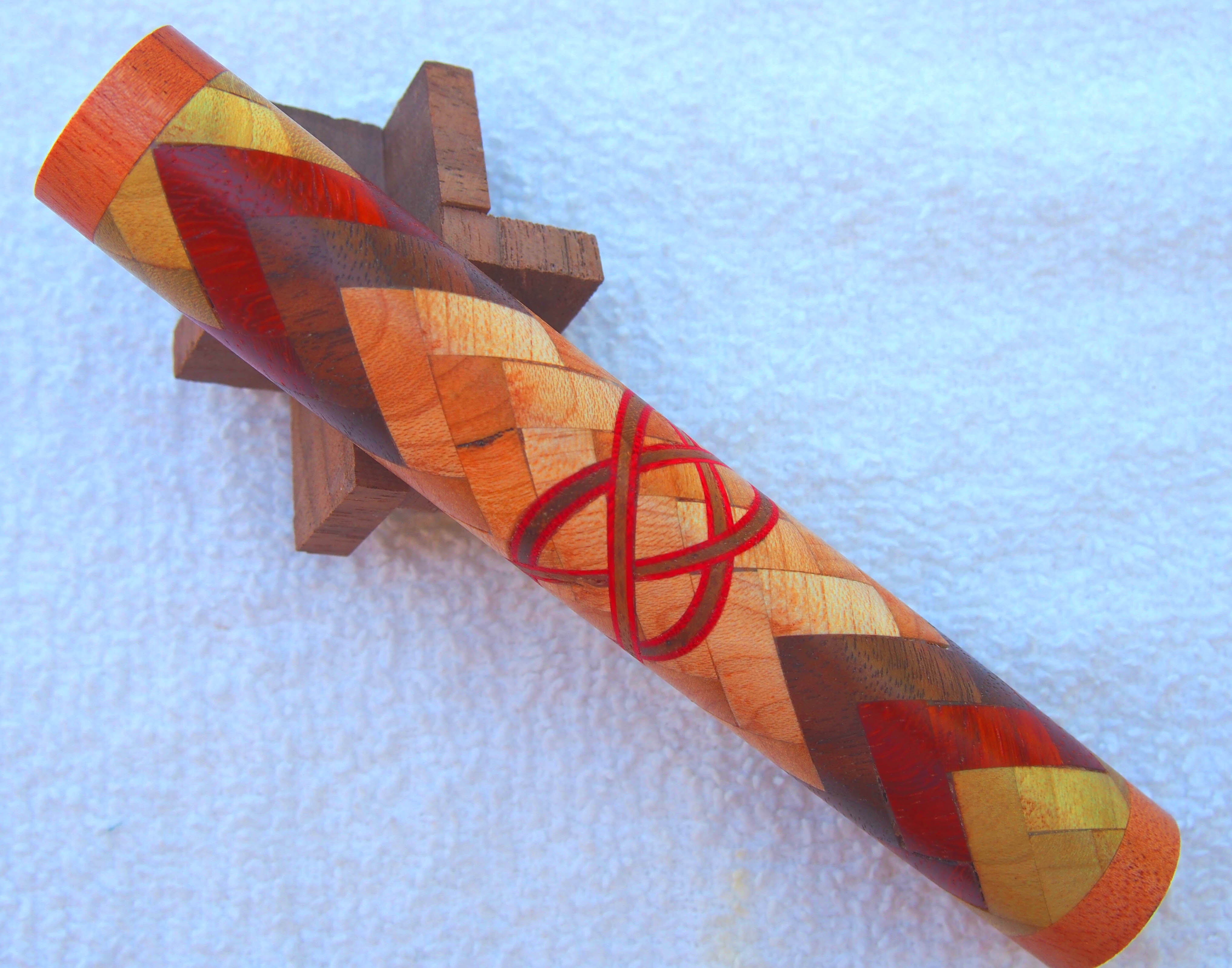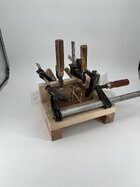Well, I haven't been here in a few months. Had some life stuff crop up. I had a project working on boxes last time I was here, which I did start exploring, but I've had to table that for now as I am lacking some tools and machines that I think are necessary to actually succeed at it. So, I've moved onto other things...
The last week or so, I've been delving into making Celtic Knot designs in various things, including pens, turned easter eggs, and rolling pins. I have only just started, but I have run into some issues gluing things up after the cuts. My original approach was to cut all the way through, add my insert layering materials and then glue everything together again. That approach has many problems, which I'm sure many of you know. So I am now trying to take the approach of making a cut with the table saw (vs. bandsaw, originally) most, but not all, of the way through my main pieces of wood. This leaves the kerf, which I then fill with exactly-matching insert material of the same width as the kerf (i.e. 5/64th). Well, that is the goal, anyway....
KERF!! My current blades, and apparently all of the available table saw (or miter saw) blades that I can find locally, are mostly Diablo (a not terribly great brand), and they don't actually explicitly state what their kerf is. My personal measurements, indicate it is somewhere a bit less than 1/8" for my miter saw blade (it measures exactly 13/128ths, just shy of 7/64ths, which is shy enough of an actual 1/8" that...it doesn't work for the 1/8" thick microlumber boards I am trying to use as the insert material. For my table saw blade, it is officially a 3/32" kerf, although some of the teeth seem to measure 13/128ths. I have wondered if it may be a bit of pitch buildup on the table saw blade (or maybe even both), so I intend to clean them. In any case, 3/32" or 6/64", is neither wide enough for some of the larger projects, nor narrow enough for the pen projects (which are definitely my smallest projects.)
The original goal was to use 1/16" thick insert material for the pen Celtic Knots, while using 1/8" thick insert material for the larger items. The pens, in fact, the intent was to glue several different layers of 1/64" thick veneers together to make a more interesting insert material, mainly three layers plus a slight bit of room for the glue line between each layer and between the insert material and the kerf in the pen blank (that final 1/64th would end up being divided up among four different layers of glue, all of which I think would end up less than 1/128" thick.)
Ok, so now for the trouble. First a 1/16" (or 4/64") 10" table saw blade does not seem to exist (well, I did find one...but it was $230!!!! I suspect there are some very specific challenges in making a blade that thin at that diameter to keep it from ripping itself apart when spinning...), although I have found a 5/64" thick blade. I would prefer to stick with the original plan of gluing together three layers of veneer, but technically I could glue together 5 layers, which would give me something slightly larger than a 5/64" thick insert...
The other challenge I've found is, full kerf (1/8" thick) blades. I seem to be finding them at two price points...about $40, and around $200! This makes me wonder a lot about the nature of a full kerf table saw blade. Should I be worried about a $40 blade? I cannot afford a $200 blade right now, or even one of the $189 Freud or CMT ones. I am curious, however, why there is such a large gap between the low end and the higher end? (Is there even a middle ground...I seem to find them pretty much at the ends of this spectrum but not really in the middle so much.)
I can probably only afford one additional blade as it is, and that will likely be the 5/64" one. So, given that...I am further curious: Is there a simple method to using a blade with a narrower kerf than you need, to cut a slot in a piece of wood, that is at an angle (60, 45, 30 or 22.5)? I have been pondering this for a bit here, and I am not sure what the best approach is. My original and naive thought was, just slide it down the fence a little bit and run the cut again... But I am not certain that is the best approach. Further, I am wondering if there is a way to do this, and maybe it is still just sliding it down the fence, that would GUARANTEE I get EXACTLY the right cut, every time. So, if I make a 3/32" cut the first pass, then I need to shave off exactly another 1/32" to get a 1/8" kerf in the wood. Does anyone know of a reliable way to do that? I could probably solve the problem if I turned on the math centers of my brain and brought out my trig again, but I am hoping there is maybe a simpler way. My second thought was, just stick a 1/32" thick thing between the stop on the fence and the wood for the first cut, then remove it for the second cut...but if the wood is at an angle, that won't really be correct. Again, I could work out the math, and I'd need to do it for at least four angles, but I'm hoping that some of you out there have solved this problem before, and there is a simpler and very ingenious way of adjusting the blank to get exactly the right kerf cut from a too-thin kerf blade.
Well, thank you for taking the time to read! I hope you are a woodworking genius!! ;D
The last week or so, I've been delving into making Celtic Knot designs in various things, including pens, turned easter eggs, and rolling pins. I have only just started, but I have run into some issues gluing things up after the cuts. My original approach was to cut all the way through, add my insert layering materials and then glue everything together again. That approach has many problems, which I'm sure many of you know. So I am now trying to take the approach of making a cut with the table saw (vs. bandsaw, originally) most, but not all, of the way through my main pieces of wood. This leaves the kerf, which I then fill with exactly-matching insert material of the same width as the kerf (i.e. 5/64th). Well, that is the goal, anyway....
KERF!! My current blades, and apparently all of the available table saw (or miter saw) blades that I can find locally, are mostly Diablo (a not terribly great brand), and they don't actually explicitly state what their kerf is. My personal measurements, indicate it is somewhere a bit less than 1/8" for my miter saw blade (it measures exactly 13/128ths, just shy of 7/64ths, which is shy enough of an actual 1/8" that...it doesn't work for the 1/8" thick microlumber boards I am trying to use as the insert material. For my table saw blade, it is officially a 3/32" kerf, although some of the teeth seem to measure 13/128ths. I have wondered if it may be a bit of pitch buildup on the table saw blade (or maybe even both), so I intend to clean them. In any case, 3/32" or 6/64", is neither wide enough for some of the larger projects, nor narrow enough for the pen projects (which are definitely my smallest projects.)
The original goal was to use 1/16" thick insert material for the pen Celtic Knots, while using 1/8" thick insert material for the larger items. The pens, in fact, the intent was to glue several different layers of 1/64" thick veneers together to make a more interesting insert material, mainly three layers plus a slight bit of room for the glue line between each layer and between the insert material and the kerf in the pen blank (that final 1/64th would end up being divided up among four different layers of glue, all of which I think would end up less than 1/128" thick.)
Ok, so now for the trouble. First a 1/16" (or 4/64") 10" table saw blade does not seem to exist (well, I did find one...but it was $230!!!! I suspect there are some very specific challenges in making a blade that thin at that diameter to keep it from ripping itself apart when spinning...), although I have found a 5/64" thick blade. I would prefer to stick with the original plan of gluing together three layers of veneer, but technically I could glue together 5 layers, which would give me something slightly larger than a 5/64" thick insert...
The other challenge I've found is, full kerf (1/8" thick) blades. I seem to be finding them at two price points...about $40, and around $200! This makes me wonder a lot about the nature of a full kerf table saw blade. Should I be worried about a $40 blade? I cannot afford a $200 blade right now, or even one of the $189 Freud or CMT ones. I am curious, however, why there is such a large gap between the low end and the higher end? (Is there even a middle ground...I seem to find them pretty much at the ends of this spectrum but not really in the middle so much.)
I can probably only afford one additional blade as it is, and that will likely be the 5/64" one. So, given that...I am further curious: Is there a simple method to using a blade with a narrower kerf than you need, to cut a slot in a piece of wood, that is at an angle (60, 45, 30 or 22.5)? I have been pondering this for a bit here, and I am not sure what the best approach is. My original and naive thought was, just slide it down the fence a little bit and run the cut again... But I am not certain that is the best approach. Further, I am wondering if there is a way to do this, and maybe it is still just sliding it down the fence, that would GUARANTEE I get EXACTLY the right cut, every time. So, if I make a 3/32" cut the first pass, then I need to shave off exactly another 1/32" to get a 1/8" kerf in the wood. Does anyone know of a reliable way to do that? I could probably solve the problem if I turned on the math centers of my brain and brought out my trig again, but I am hoping there is maybe a simpler way. My second thought was, just stick a 1/32" thick thing between the stop on the fence and the wood for the first cut, then remove it for the second cut...but if the wood is at an angle, that won't really be correct. Again, I could work out the math, and I'd need to do it for at least four angles, but I'm hoping that some of you out there have solved this problem before, and there is a simpler and very ingenious way of adjusting the blank to get exactly the right kerf cut from a too-thin kerf blade.
Well, thank you for taking the time to read! I hope you are a woodworking genius!! ;D



